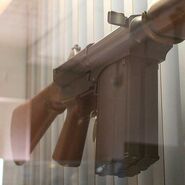The SALVO rifle is an experimental double-barreled 5.56mm automatic rifle co-developed by Olin and Winchester for the U.S. Army's SALVO project in the 1950s.
Developed in hopes of increasing the hit probability of soldiers in combat, the SALVO rifle was designed by Stefan K. Janson, who had previously created the Enfield EM-2 bullpup rifle for the British Army.
Design Details[]
The SALVO rifle design appears to be a pair of FN FAL rifles grafted together, sharing a single gas system on a custom-built receiver. It is based on the T48 rifle, which, in turn, was a license-produced version of the FAL.
The SALVO rifle was chambered for the experimental 5.56mm T65 Duplex cartridge, based on a long-necked variant of the 7.62×51mm NATO cartridge case loaded with a pair of conventional projectiles. Two variants of the duplex cartridge existed: one fired two 35 grain projectiles at 3,505 ft/s, while the other fired a pair of 41 grain bullets at 3,250 ft/s.
With its two barrels each firing a duplex cartridge, the SALVO rifle would effectively launch four projectiles with every press of the trigger. However, this proved to be the SALVO rifle's downfall as the recoil of firing two duplex cartridges at the same time exceeded that of the M1 Garand.
An example of the SALVO rifle is currently held in the collection of the Springfield Armory Museum.
Gallery[]
See also[]
- Project SALVO
- Springfield Armory SALVO rifle
- 5.56mm T65 Duplex
- Multiplex ammunition
References[]
- http://www.rediscov.com/spring/full/P_MUSEUM-SERVICES_IMAGES_OBJECT-IMAGES_1001-1500_1261.jpg
- http://www.rediscov.com/spring/VFPCGI.exe?IDCFile=/spring/DETAILS.IDC,SPECIFIC=594,DATABASE=objects,
- http://www.thegunzone.com/spiw.html
- http://www.google.com/patents?id=IoJgAAAAEBAJ&pg=PA1&dq=&source=gbs_selected_pages&cad=0_1#PPA1,M1
- http://www.thefirearmblog.com/blog/2014/11/18/came-1956-double-barreled-winchester-salvo-rifle/
- http://www.gunsholstersandgear.com/winchester-salvo-rifle/
- PDF on Phase 2 of Project Salvo
| ||||||||||||||||||||||||||||||||||||||||||||||||||||||||












